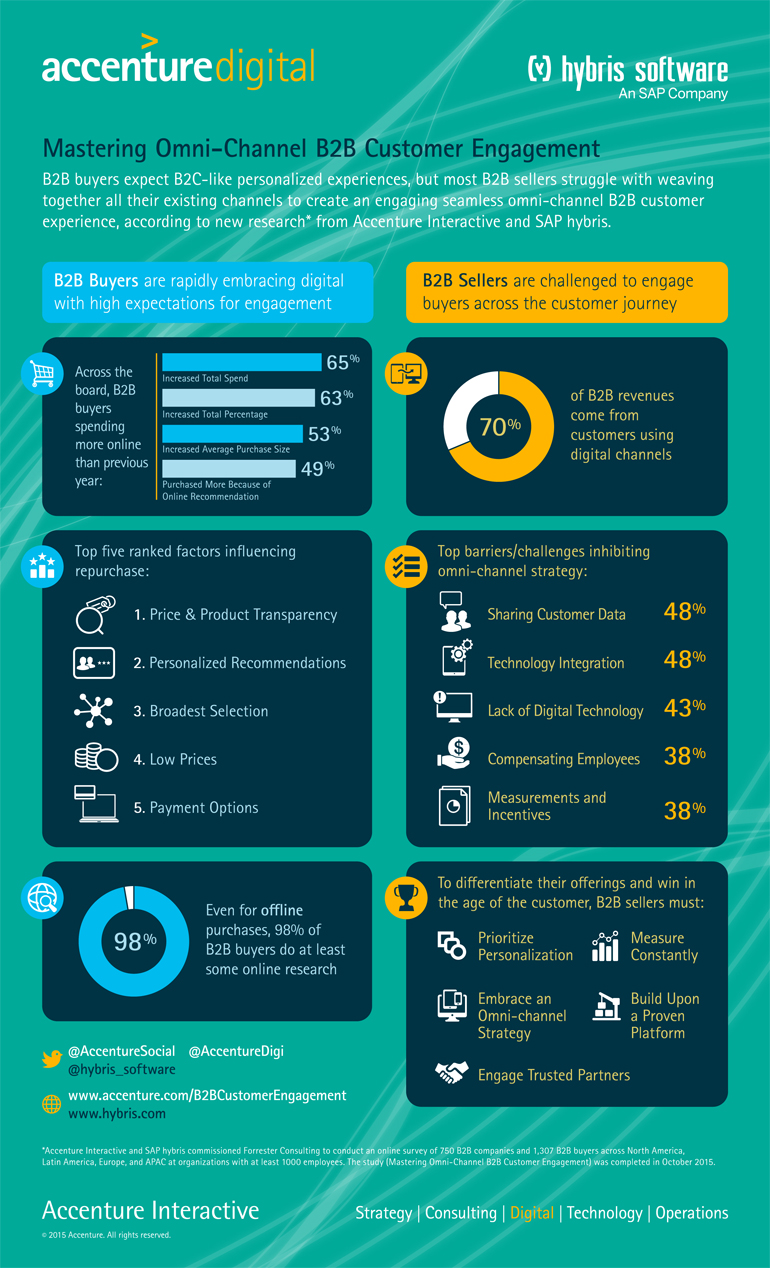- Category: December 2015 - Omnichannel Marketing
 Creating a personalized and seamless omnichannel experience involves integrating a myriad of people, processes, technology, and data to enable channels to share information close to real time, states Forrester Consulting in its Thought Leadership Paper Mastering Omnichannel B2B Customer Engagement, commissioned by Accenture Interactive and SAP hybris.
Creating a personalized and seamless omnichannel experience involves integrating a myriad of people, processes, technology, and data to enable channels to share information close to real time, states Forrester Consulting in its Thought Leadership Paper Mastering Omnichannel B2B Customer Engagement, commissioned by Accenture Interactive and SAP hybris.
The research found that B2B sellers still have a hard time meeting buyers’ expectations across the customer journey, revealing the following:
1. B2B firms face challenges with technology, data silos, and measurement, finding it “difficulty sharing customer data and analytics between channels, countries, or locations, besides mentioning a “lack of the right business measurements and incentives.” Sellers cannot create personalized experiences if their various systems can’t talk to each other, nor can they easily improve their customer engagement based on the data that they do have access to if they aren’t even sure what to measure.
2. Sellers face sales and marketing challenges across all phases of the customer journey, especially when dealing with personalization, as disparate systems and processes complicate data aggregation and sharing efforts.
3. Most customer data is only available in some channels, but not all. B2B sellers said that although they have customers’ names, purchase/service histories, and business backgrounds available fairly broadly, they don’t have other critical personalization data, such as pricing, available across all channels.
Indeed, omnichannel solutions are not possible without technologies and enabling business processes capable of providing consistent and responsive content, data, and transaction services to all channels at the customer’s moment of need. Therefore, sellers are on the right track in working to implement omnichannel touchpoints, but must accelerate the integration of technology platforms with people and Agile processes to support a real-time operating environment. According to Forrester’s findings, creating personalized omnichannel engagement requires:
According to Forrester’s findings, creating personalized omnichannel engagement requires:
1. Technology that supports today’s complex customer journey, since customers largely enjoy the freedom to take whatever path to purchase they desire, which requires a multistep process:
• Mapping customer journeys to understand typical customers’ interests and behaviors.
• Determining what capabilities your company needs to serve the customers on their journey.
• Comparing these capabilities to your systems of engagement to see where you have gaps that can either be filled by existing systems or through new investments
Different technology solutions help facilitate engagement at various stages in the customer journey — although most will overlap and touch the customer more than once. Once you have figured out what capabilities you have, the key is making sure that you have a platform in place that allows you to extend those capabilities across channels.
2. Agile processes for analysis and refinement, as the digital landscape and customer needs are constantly evolving. Organizations should take an iterative approach to prototyping, developing, testing, and fine-tuning solutions. With the customer journey in mind, businesses should engage in a continuous cycle of identifying customer needs, designing a digital engagement they want to deliver, engineering the delivery of that engagement, and then analyzing results.
3. The right people and partners that are committed to delivering digital and customer experience excellence and willing to rally the company around these shared goals. Beyond leadership, companies need access to various strategic, technical, and customer experience skillsets, therefore many turn to third parties to help fill gaps and speed time-to-market for new initiatives to be successful in today’s omnichannel world.
Source: Forrester Research



















